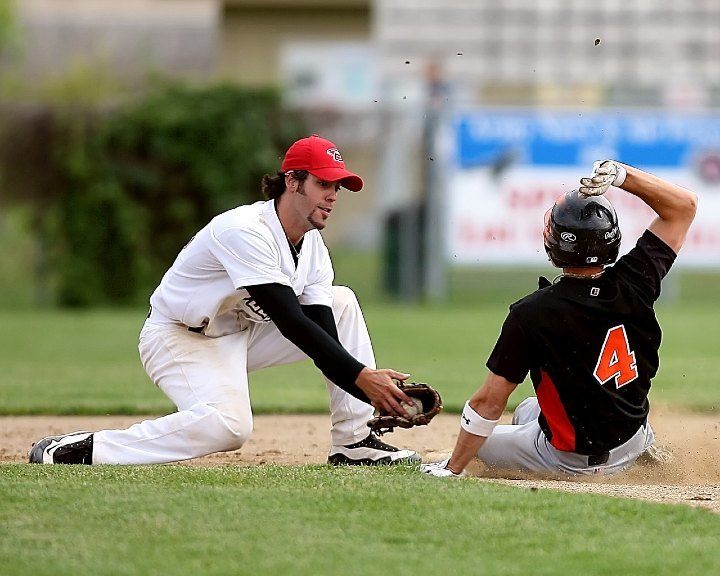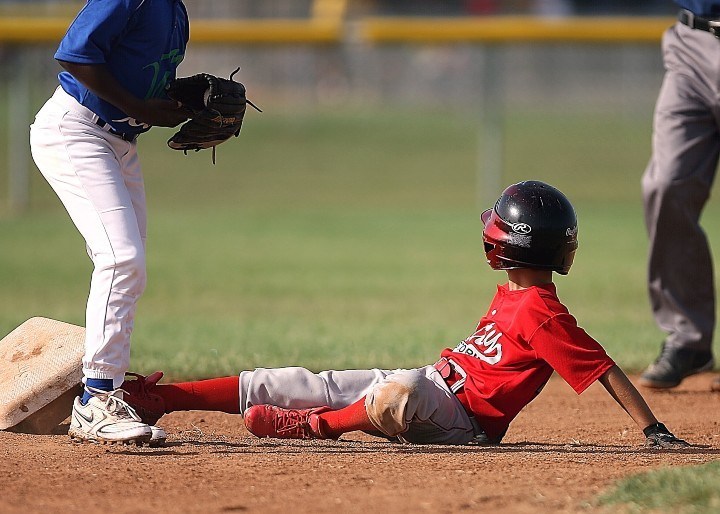When there are bang-bang plays in baseball, every inch and every second can make a difference.
With base runners going at full speed to try to beat a throw from a fielder, they will oftentimes perform a slide to try to get to the base faster and safer, while avoiding a tag at the same time.
Knowing how to slide in baseball may seem like a simple thing to do, but it takes some guidance and practice to learn how to do it well.
A slide that is executed perfectly can make the difference between the runner making it safely to the base or being thrown out.
There are a few different types of slides, and different ways to execute them.
Let's start with a step-by-step guide on how to perform the most basic slide in baseball -- the bent-leg slide.

The Bent-Leg Slide (6-Step Guide)
A great way to learn how to slide in baseball is to do it without running at first.
Simply complete the steps from a still position so you can learn what you should be doing with your body.
Once you have the steps down, then you can put the practice in motion by sliding on a dirt base path or by laying down a tarp on a grass surface.
Step #1: Sit on the Dirt
When you perform a bent-leg slide, you'll be doing so from what is essentially a seated position on the ground.
The first step in doing this is to sit on the ground with your legs directly straight in front of your body.
You'll then want to fold one of your leg under the opposite knee so that you form what is essentially a figure-4 with the position of your legs.
Most commonly, right-handed players will bend their left leg under their right knee, and vice versa.
However, it doesn't matter which leg you bend under which knee.
It's totally up to whatever is most comfortable.
Step #2: Center Your Weight on Your Butt
The tendency for many would be to slide on the side of their body.
Not only is it usually easier to do, but a lot of players find it more comfortable as well. If you do this, though, you'll be susceptible to scrapes and bruises on your legs and possibly even more serious injuries.
The best way for you to sit when you slide is straight on your butt.
It's the part of your body that is cushioned the most, making it both the safest and least painful way to perform a slide.
Step #3: Raise Your Arms and Hands
Another way to protect yourself while you slide is to put your arms and hands straight in the air.
This will help protect you against jamming your wrists while you slide.
You want to make sure your arms are slightly bent and that your hands are raised slightly above your head.
This will ensure that your hands or arms don't drag on the ground while you slide, which obviously could cause you to suffer scrapes, bruises, or even a more serious hand, wrist, or finger injury.
Surprisingly, throwing your arms and hands up in the air while you slide will help you to keep perfect balance.

Step #4: Tuck Your Chin Down
Balance is key when you slide.
The motion of running fast and then abruptly changing your position will throw your normal balance off.
To make sure you keep the proper balance during your slide, and avoid rolling to one side or the other, you want to keep the core of your body tight, and also tuck your chin down into your chest.
These actions will prevent your head from being thrown to the back while you slide. If it does this, you run the risk of hitting the back of your head on the ground, which can result in a major head injury.
While the motion of sliding will naturally pull you to lean your body back slightly, you want to make sure that you aren't throwing your chest back.
Let gravity and your momentum do the work for you.
Don't force it.
Those first four steps dealt exclusively with the mechanics of completing a slide, but they didn't deal at all with when to start your slide in relation to the bag and how to complete your slide.
Step #5: Start Your Slide
When you're in a game, you'll be running full speed toward the next bag.
If it's likely that there will be a close tag play at the bag, then you'll want to make sure you slide.
When you're about three to five feet away from the bag, start your slide by tucking your one leg under the opposite knee and then getting down to the ground on your butt (with your arms and hands in the air).
Step #6: Complete Your Slide
The goal with a slide is to help you avoid a tag from the fielder who is positioned at the base you're trying to get to.
More experienced players may try to look back at where the ball is coming from to judge where on the base directionally the tag will be going.
If you're new to baseball and are just learning to slide, however, an easy way to try to tell what side of the bag the tag will be going is where the fielder moves his body and positions his glove.
If he leans toward the front of the bag, then the tag will most likely be going there.
If he leans toward the back, then the tag will most likely be going there.
If you are able to judge where the tag will be going, then you should attempt to slide to the other side of the bag.
Aim your foot to either the front or back corner of the bag, and the rest of your body will follow.
Once you have mastered this most common type of slide, you can work on two different variations -- the hook slide and the head-first slide.
The Hook Slide
The hook slide is just a slight variation to the bent-knee slide.
Every step you take will be exactly the same as above, except for the end.
Instead of sliding into the bag directly with your feet, you instead be "hooking" around the bag with your body and grabbing the base with your arm.
This is an advanced version of what we talked about above -- sliding to one side of the bag to avoid a tag.
If you are a more advanced player, or have mastered the bent-knee slide, then you can move onto the hook slide.
The key to performing a hook slide is recognizing early enough what side of the bag the tag will be going.
That's because you'll need to slide completely off to the other side of the bag to make it harder for the fielder to tag you out.
To perform a hook slide, start your slide slightly later than a normal bent-knee slide, since you'll be sliding past the base.
You won't want to have your slide stop at the base.
Aim your slide slightly off to one side of the bag.
Let your body slide past the bag to that side, and then grab the bag with your arm and hand as you slide by it.
This can be a slide you attempt if you’re anticipating where the tag will be, or if the fielder already has the ball in his glove and has placed it to either side of the bag.
The Headfirst Slide
You will see many players in professional baseball perform the headfirst slide rather than the bent-knee slide.
That's because it is a faster slide because it allows you to work with the natural momentum of your body.
Your entire motion will be forward, as opposed to some of your motion going slightly back in a bent-knee slide.
At the same time, the headfirst slide can be more dangerous than the bent-knee slide, which is why you should only try to perform one if you're a more advanced player.
Not only will you run the risk of suffering jammed hands and wrists, but you could also hurt your neck and head if you don't perform the slide correctly.
To perform a headfirst slide, you'll run full-speed toward the bag like you do with a bent-knee slide, but then you'll lean and dive forward horizontally.
The goal is to hit the ground by landing on your chest and the heel of your hands. To do so, you want to make sure your palms are down, but keep your fingers off the dirt.
This will help you avoid jamming them badly or bending them awkwardly.
Make sure you make contact with the ground in this way, and not on your stomach, which could cause injury to your core and also throw your slide off completely.
When you slide into the bag, make sure that your arms are stretched out but there is a little "give" to them. You don't want to have a perfectly stiff arm. This could cause you to jam your wrists, elbows and/or shoulders badly when you make contact with the bag.
If you need to stop your slide with something other than your hands, you can simply dig your toes into the ground, which will create the friction necessary to slow you down.
Again, you only want to attempt a headfirst slide if you are a more advanced player.
It is not advised for beginners or youth players.
Conclusion
The slide is one of the most important skills that a base runner can learn in baseball.
It helps you not only avoid a tag play at a base, but get there faster.
While sliding may seem simple enough, there are specific steps you should take to learn how to slide in baseball the right way.
Remember, you should practice the body position of your slide first from a non-moving position.
Once you have your body position down and everything feels comfortable, then you can try practicing by laying a tarp down over grass.

